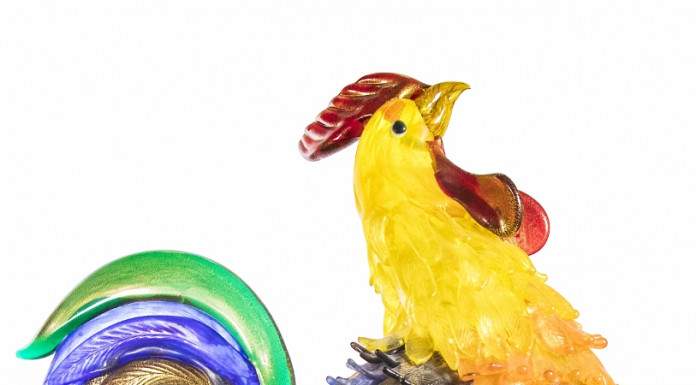Asti, at Palazzo Mazzetti the glass collected by Pino and Donatella Clinanti
After the major exhibition The Macchiaioli. The Adventure of Modern Art that ended with great public success last June 5, from June 25 to October 16, Palazzo Mazzetti in Asti opens its doors to The Glass is Life. The Pino and Donatella Clinanti Collection. In continuity with the exhibition on the tapestries of Asti held between 2020 and 2021, Palazzo Mazzetti offers a new exhibition dedicated to the territory and local collecting and, in the International Year of Glass, designated by the United Nations, hosts the precious collection of glass born from the collecting passion of Pino Clinanti and continued with enthusiasm by his daughter Donatella.
Within an itinerary that chronicles the use of glass in art through the centuries, the collection bears witness to the intertwining of life and aesthetic feeling of engineer Pino Clinanti (1914 - 2007) and is made extraordinary by the presence of an important and ancient nucleus of containers made of lattimo glass (a “mimetic” glass that is opaque white like milk, dating from around 1450 and used as an imitation of Chinese porcelain that arrived in Venice), a material of which Clinanti was a great scholar. Various specimens in the exhibition narrate the special and ornate “forms of drinking,” narrated by antique wine and liquor bottles, delicate carafes, glasses, chalices and decorative objects produced by Venetian, Italian and foreign manufactures that testify to the use of glass between the 17th and 20th centuries.
In addition to blown, etched or enameled glass, the works on display are made with well-known decorative techniques, starting with filigree lattice lattimo glass, which creates the effect of lace within the glass wall. This is followed by goblets with “comb” or “graffito” decoration of ancient origin, obtained by applying combed threads of lattimo to the blown glass paste and thus incorporated into the surface. The different types of glass also include aventurine and chalcedony, invented in Murano (the former in the 17th century and the latter in the 14th century) to imitate aventurine quartz and semiprecious stones, such as agate, and onyx, malachite, lapis lazuli and jasper, respectively.
Displayed along with these are fine Art Nouveau vases also belonging to the Clinanti collection, such as a green glass vase decorated with peonies, a red bell vase of French manufacture, and, most importantly, a small vase decorated with violets signed by the Daum manufacture, the famous Nancy glassworks founded in 1878 by Jean Daum, whose sons quickly became a major force in the Art Nouveau movement.
To open the exhibition, a portrait of engineer Pino Clinanti carved in a crystal monoblock welcomes visitors. An exhibition room, on the other hand, welcomes the polychrome Murano glass rooster, which, together with the crystal specimen signed Lalique, pays homage to Asti, of which it is the symbolic animal, inviting citizens to watch over their freedom. In fact, the rooster is the emblem of municipal freedom and has been the terminal ornament of the dome of the Collegiate Church of San Secondo since the 13th century.
The exhibition could not fail to include a section devoted to glassmaking, which has been present in the Asti area since 1906. O-I Italy, the Italian subsidiary of O-I Glass - a world leader in the production of glass packaging for the food and beverage industry, with more than 24.000 employees and 70 plants in 19 countries - is pleased and proud to have the opportunity to participate (in the context of the year of glass decreed by the UN), with a space dedicated to the exhibition Glass is life because the life of the Asti territory is at the same time strongly linked to glass in a circular economy process that highlights the sustainability of glass and the company.
The exhibition Glass is Life. The Pino and Donatella Clinanti Collection is produced by the Asti Musei Foundation, the Fondazione Cassa di Risparmio di Asti, the Piedmont Region, the Municipality of Asti and the Chamber of Commerce of Asti, has the Banca di Asti Group as sponsor, is in collaboration with O-I Italy, with communication and promotion by Arthemisia. Engineer Pino Clinanti worked at the Asti Glassworks until 1984, first as technical director and later as director of the Corso Cavallotti plant. He lived through the transition from glass “blowers” to the first machines. He coordinated new technologies and personally collaborated in all the gradual expansions of the production departments, as well as the transition of the plant from Saciv toAvir. Later appointed managing director of Avir, Clinanti directed all the group’s plants, from the one in Asti to those in Sesto Calende, Corsico, San Polo sul Piave, Gaeta and Aprilia. In the mid-1980s he was appointed president of theIndustrial Union of Asti. His passion and great experience in the field of glassmaking led the engineer to chair the Experimental Glass Station in Murano. Among the leading experts in the field he collaborated with the glass museums of Altare and Montalcino. Despite everything he liked to call himself simply a “glassmaker.”
From Ancient Glass to the Modern Bottle is the text written by Clinanti for the volume dedicated to the Sienese museum and entitled Il Fuoco il Vetro il Vino published in 1992. The engineer, a man full of interest, was also the founder of the Asti Delegation of theItalian Academy of Cuisine, the 60th anniversary of whose founding falls this very year.
For all information, you can visit the official website of the Asti Museums.
Pictured: polychrome Murano glass rooster, 19th century.
 |
| Asti, at Palazzo Mazzetti the glass collected by Pino and Donatella Clinanti |
Warning: the translation into English of the original Italian article was created using automatic tools. We undertake to review all articles, but we do not guarantee the total absence of inaccuracies in the translation due to the program. You can find the original by clicking on the ITA button. If you find any mistake,please contact us.




























